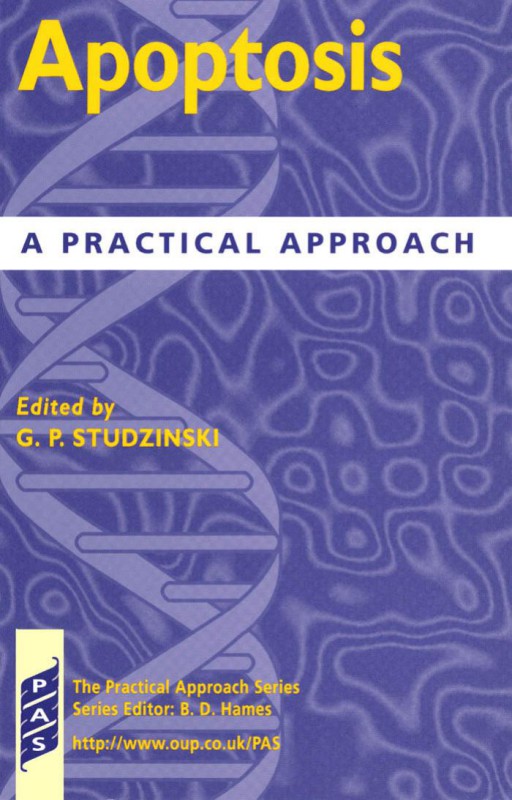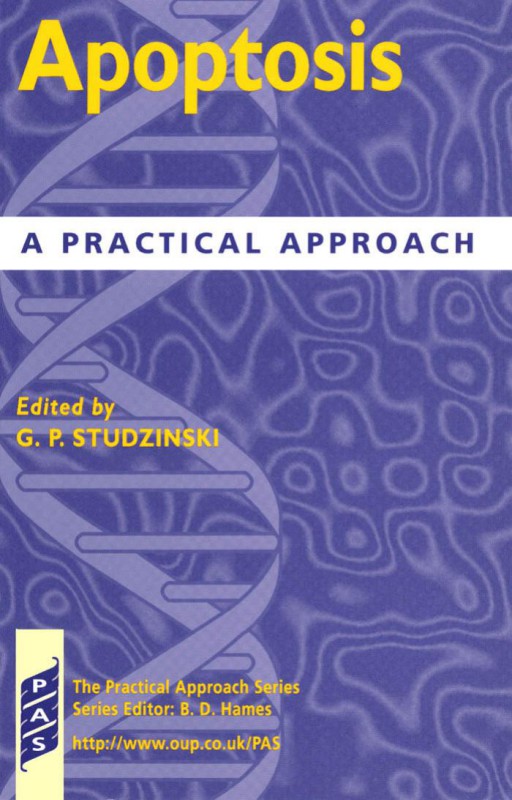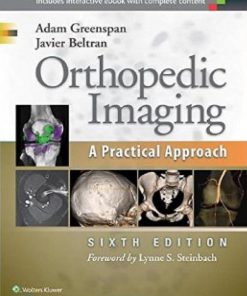Apoptosis a practical approach 1st Edition by GP Studzinski, BD Hames ISBN 9780191566004 0191566004
$50.00 Original price was: $50.00.$25.00Current price is: $25.00.
Authors:G. Studzinski , Series:Pathology [7] , Tags:Pathology , Author sort:Studzinski, G. , Languages:Languages:eng , Published:Published:May 2007 , Publisher:Oxford University Press , Comments:Comments:Apoptosis, a concept derived from pathological observations dating back to the availability of the microscope, has been recently afforded treatment reminiscent of the ancient apocalyptic writings. Revelations are reported daily of new, and so it is claimed, profound insights into cellular survival mechanisms, and their principal default pathway, apoptosis. The preoccupation of many scientists with this cellular programme, or programmes, appears to be driven by several currents. There is a bewildering array of commercial reagents and accompanying literature reporting to provide, often quick and easy, means of discovering important secrets of nature. There is also the fascination of the scientists with the beauty of an almost endless cascades of protein-protein interactions that lead to an irrevocable end-point—cell death. And of course, there is the legitimate expectation that important components of therapy for cancer and immune diseases will be based on our understanding of the precise mechanisms of these apoptotic cascades.
Apoptosis a practical approach 1st Edition by GP Studzinski, BD Hames – Ebook PDF Instant Download/Delivery. 9780191566004 ,0191566004
Full download Apoptosis a practical approach 1st Edition after payment

Product details:
ISBN 10: 0191566004
ISBN 13: 9780191566004
Author: GP Studzinski, BD Hames
Apoptosis a practical approach 1st Edition Table of contents:
1. Overview of apoptosis
1. General introduction and overview of contents
2. Historical perspective
3. Distinction of apoptosis from other forms of cell death
4. Apoptotic cascades
5. Time course of apoptotic cascades
6. Selection of methods
Procedure for determination of increased mitochondrial to nuclear DNA ratio, for the detection and q
7. Pitfalls
References
2. Morphological recognition of apoptotic cells
1. Introduction
Key morphological features of apoptotic cells
2. Light and fluorescent microscopy techniques for the assessment of apoptosis
Preparation of cell or tissue samples
Nuclear counterstains
3. Electron microscopic techniques
4. Quantitation of apoptotic events
Methods
Problems in scoring apoptotic events
5. In situ detection of DNA strand breaks
6. Other techniques
7. Conclusions
References
3. Assessment of DNA damage in apoptosis
1. Introduction
2. Types of DNA fragmentation
3. Measurement of high molecular weight DNA fragmentation by pulse-field gel electrophoresis
Pulse-field gel electrophoresis procedures
Strategies for electrophoretic separations
4. Detection of internucleosomal DNA fragmentation by standard agarose gel electrophoresis
5. Filter elution assay to measure apoptotic DNA fragmentation
Equipment
Filters and solutions
DNA labelling and preparation of experimental cell cultures
Protocols
Counting samples and computations
References
4. Analysis of cell death by flow and laser-scanning cytometry
1. Introduction
2. Preparation of cells for analysis by LSC. Detection of apoptotic cells based on changes in nuclea
3. Light-scattering properties of apoptotic and necrotic cells
4. Analysis of mitochondrial transmembrane potential (Δψ[sub(m)])
5. Detection of apoptotic cells exposing phosphatidylserine on plasma membrane
6. Detection of apoptotic cells based on their fractional DNA content
7. Identification of apoptotic cells based on the presence of DNA strand breaks
8. Identification of apoptotic cells based on the increased DNA sensitivity to denaturation
9. General comments
References
5. Cell-mediated cytotoxicity and cell death receptors
1. Overview of pathways for cell-mediated cytotoxicity
Fas-based cytotoxicity
Perforin/granzyme-based cytotoxicity
2. Standard methods for the evaluation of cell-mediated cytotoxicity
Chromium release assay
[[sup(125)]I]Iododeoxyuridine ([sup(125)]IUdR) release assayThe JAM test
BLT–esterase release assay
Estimation of target cell nuclear fragmentation using fluorescent dyes
Activation-induced cell death (AICD)
3. Separate studies of Fas- and perforin/granzyme-based cytotoxicity
Fas-based cytotoxicity in the absence of perforin/granzyme contribution
Perforin/granzyme-based cytotoxicity in the absence of FasL contribution
4. Use of caspase and granzyme inhibitors in cell-mediated cytotoxicity assays
Caspase inhibitors
Granzyme inhibitors
References
6. Sphingolipids as messengers of cell death
1. Introduction
2. Sphingolipids and their role in apoptosis
Overview of Sphingolipids
Role of Sphingolipids in apoptosis
Strategies and considerations in evaluating Sphingolipids
3. Extraction of Sphingolipids and normalization by lipid phosphate
Extraction of sphingosines, ceramides, and sphingomyelins
Alkaline hydrolysis of Sphingolipids
Lipid phosphate measurement for normalization of experimental samples
4. Analysis of sphingoid backbones
HPLC on sphingoid backbones
5. Analysis of ceramides
6. Analysis of sphingomyelins
7. Measurement of SMase and SM synthase activities
References
7. Cytochemical detection of cytoskeletal and nucleoskeletal changes during apoptosis
1. Introduction
2. Cyto- and nucleoskeletal changes during apoptosis
General
Microfilaments and microfilament-associated proteins
Microtubules
Intermediate filaments
Nucleoskeletal components
Generation of neo-epitopes in cytoskeletal proteins during apoptosis
3. Apoptosis detection systems
Overview
The annexin V affinity assay
Detection of apoptosis using the TUNEL assay
References
8. Metabolic alterations associated with apoptosis
1. Introduction
2. Detection of changes in the mitochondrial transmembrane potential
3. Detection of intracellular reactive oxygen intermediates (ROI)
4. Determination of glutathione levels and its oxidative state
5. Measurement of catalase in cells undergoing apoptosis
References
9. Methods of measuring Bcl-2 family proteins and their functions
1. Introduction
2. Immunoblot analysis
Cell lysis and tissue processing procedures
Immunoblotting procedure
3. Detection of Bcl-2 family proteins by flow cytometry (FACS)
Indirect immunofluorescence procedure
Antibodies
4. Northern blot analysis of BCL-2 mRNA
General guidelines for RNA blotting
Pre-hybridization and hybridization procedures
Solutions
5. Reverse transcriptase-polymerase chain reaction (RT-PCR)
cDNA synthesis
PCR amplication
Southern blot analysis of PCR products
Primers and probes for PCR
6. Immunohistochemical detection of Bcl-2 family proteins in tissues
Procedures for tissue preparation, embedding, and sectioning
Pre-staining sample preparation
Immunostaining
Counterstaining and mounting
Solutions
7. Immunohistochemical detection of Bcl-2 protein in cultured cells
Procedures
Immunostaining
Solutions
8. Production of recombinant Bcl-2 family proteins in bacteria
Human Bcl-2
Human Bcl-X[sub(L)] protein
Mouse Bax protein
Human Bid protein
9. Measurements of pore formation by Bcl-2 family proteins
Liposome preparation
Channel activity measurements
10. Methods of assaying Bcl-2 and Bax family protein function in yeast
Plasmid considerations
Saccharomyces cerevisiae strains
Media and growth conditions
Transformation of S. cerevisiae by the LiOAc method
Assay for Bax-induced lethality in S. cerevisiae
11. Summary
References
10. Methods for detecting proteolysis during apoptosis in intact cells
1. Introduction
2. Involvement of proteases in apoptosis
3. Caspase nomenclature and classification
4. Detection of procaspases and their cleavage products by immunoblotting
Theoretical considerations
Practical considerations in immunoblotting for caspases
Sample preparation and immunoblotting
5. Cleavage of caspase targets
Establishing that proteases are activated in situ
Establishing that a polypeptide is cleaved by caspases
6. Assays of caspase activity
Theoretical considerations of caspase activity assays
Measuring caspase activity in cell lysates
7. Detection of active caspases by affinity labelling
Theoretical considerations in affinity labelling
Practical considerations in the use of affinity labelling reagents
Labelling and detecting enzymatically active caspases
8. Studying the biological effects of caspase cleavages
A molecular approach for analysis of the effects of substrate cleavage
Use of caspase inhibitors: promises and pitfalls
References
List of Suppliers
Index
People also search for Apoptosis a practical approach 1st Edition:
apoptosis assay
apoptosis experiment
a topical approach to lifespan development 11th edition access code
apoptosis ap biology
You may also like…
eBook PDF
Apoptosis Techniques and Protocols 2nd Edition by Andréa LeBlanc ISBN 9781592591886 159259188X
eBook PDF
Orthopedic Imaging A Practical Approach 6th Edition by Adam Greenspan ISBN 1451191308 9781451191301
eBook PDF
Cosmetic Microbiology A Practical Approach 2nd edition by Philip Geis ISBN 0849314534 978-0849314537












